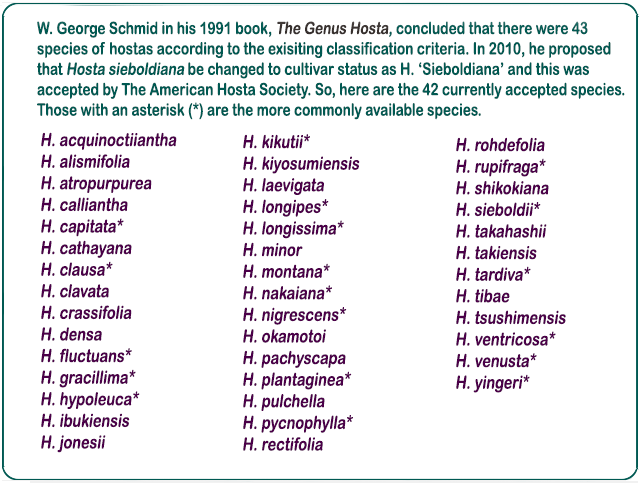|
The next step down the ladder in the
classification system is the species. Here again, it can get a bit
confusing but hang in there and you will soon understand it...I
hope.
 A species name is formed by taking the genus
name and adding what is called a specific epithet. This second word
is comprised of a person's name, a descriptive term, a location name
or some other word designated by the one who discovered the plant in
the wild or later named the species. As we mentioned before, the
words are all "Latinized." In some cases, the words are actual Latin
or they may be words in English, Greek or other languages that
people then translate into a Latin form by adding Latin suffixes or
prefixes. A species name is formed by taking the genus
name and adding what is called a specific epithet. This second word
is comprised of a person's name, a descriptive term, a location name
or some other word designated by the one who discovered the plant in
the wild or later named the species. As we mentioned before, the
words are all "Latinized." In some cases, the words are actual Latin
or they may be words in English, Greek or other languages that
people then translate into a Latin form by adding Latin suffixes or
prefixes.
 For example, a man named
Phillip von Siebold (more on him later) found several different
types of hostas growing in Asia back in the 1800s. When he brought
them to Europe, two of them were named in his honor. Thus we have
Hosta sieboldiana (now H. 'Sieboldiana') and
Hosta sieboldii as species names. For example, a man named
Phillip von Siebold (more on him later) found several different
types of hostas growing in Asia back in the 1800s. When he brought
them to Europe, two of them were named in his honor. Thus we have
Hosta sieboldiana (now H. 'Sieboldiana') and
Hosta sieboldii as species names.
As you can see, the species names consist of
the genus name which is capitalized and the specific epithet which
is almost always in lower case. Both are either italicized if
machine printed or underlined if hand written.
Here are some Latin words and phrases that have
been used in the naming of hosta species:
Taxonomists argue all the time over what actually traits
to use to qualify a group of plants to be a species. However, for
our purposes, we will narrow it down to a couple of key factors. One
is that members of a species are able to freely interbreed and
produce fertile offspring. The second factor is that a population of
these plants currently resides in the "wild" or that there is
evidence i.e. fossils, herbarium specimens, documents, etc. that
show that they once did.


Schmid changed several species to cultivar status.
For more... |



